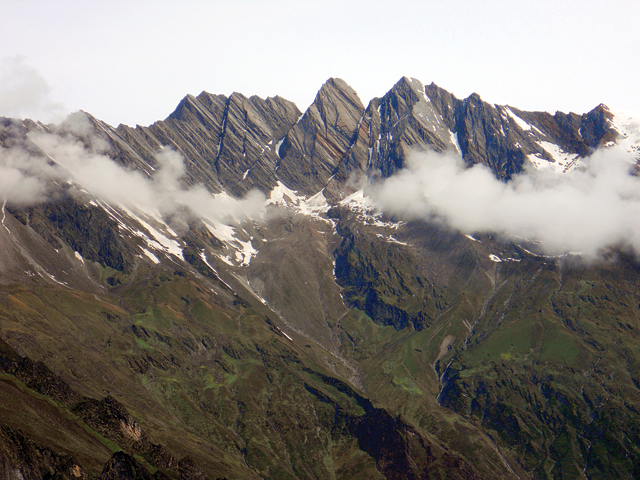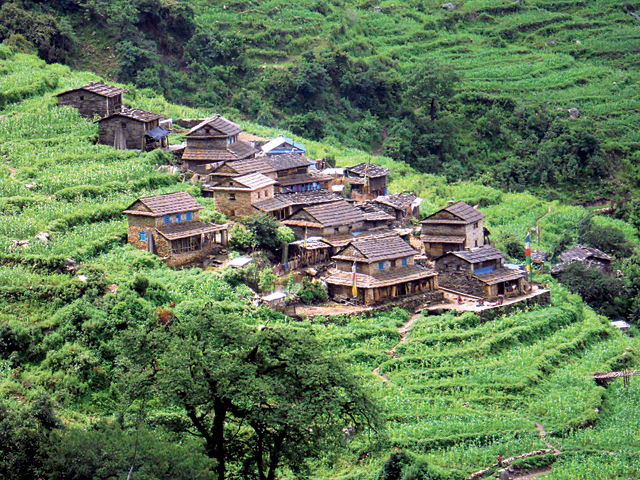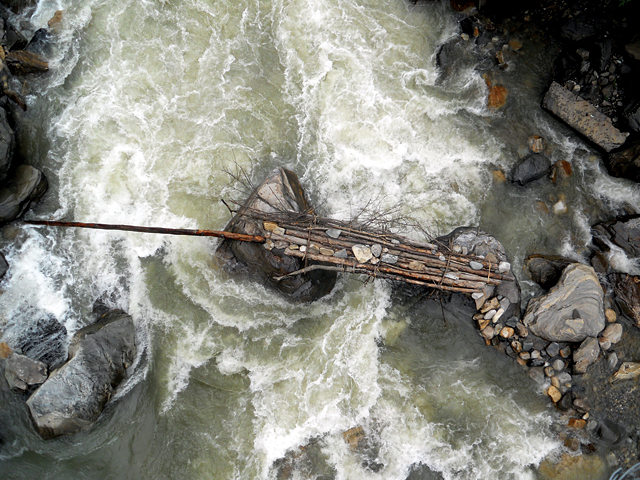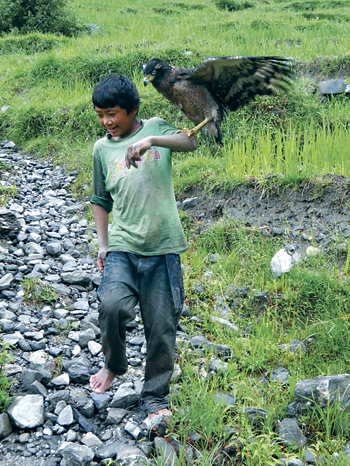The geographical and historical heartland of Nepal has been renovated for tourism. These secluded, emerald hills which were once the homeland to Gorkhali warriors offer robust cultural attractions, and distant views of the Himalayas towering into the skies.

It was invitation only – a venture into secluded hills where few tourists have set foot. I was the lone foreigner on a twenty-eight-man mission. Having never been paid to trek, I agreed without a second thought despite departing during the madness of monsoon.
Saroj Neupane, the exploration leader, had me sign a contract at his office, Beyond the Limits Trekking, in Thamel, and I was glad to. Previously, a local publisher burned me for lack of written paperwork – I learned from them that a gentlemen’s agreement requires gentlemen. In any case, paperwork is essential, even between friends and especially outsiders.
“I can’t let you know specific details now, they are secret,” Neupane informed me. I only knew that we were going deep into central Nepal, the Ganesh Himal Region. It lies north of the bitumen artery connecting frenetic Kathmandu with tourist Shangrila, Pokhara. This area is draped with scenic natural appeal and includes Gorkha, Dhading, Rasuwa, and Nuwakot districts.
We headed into the emerald hills where Gurkha warriors were recruited by local chieftain Prithvi Narayan Shah. They emerged from their sun-kissed homeland to consolidate a country in the late 1700s. The triumph was complete only after vanquishing the three Newar kingdoms of Kathmandu Valley, weakened by jealousy and internecine bickering. The result was the Shah dynasty reign of 239 years (with a 100 year hiccup when the Rana’s overmastered the royals).
The homeland of the former conquerors is now being invaded by good-willed development workers aiming for prosperity. The UK’s Department for International Development (DFID), working with the Trekking Agencies Association of Nepal (TAAN), the Dhading District Development Committee (DDC), and a non-government organization named SAMARTH, are pouring resources (including over Rs. 3,200,000) into the region to develop and widen trails, install view towers, build bridges and porter shelters, and construct other facilities for trekkers. The first phase of this fast-paced work will be completed in August.
“This area is hidden, and because of a lack of promotion, most people don’t know about it,” explains Dhading native Shiva Shrestha, newscaster for Kathmandu’s All 3 Media House. The Ganesh Himal Region with Ruby Valley is sandwiched between two prominent trekking entrees, the Mansalu Conservation Area Project and Langtang National Park. These neighboring, well-established destinations are the bread that overpowers the filling, the Ganesh Himal Region, off the tourist grid awaiting greater discovery. “Nepal’s leading destinations are unbeatable when it comes to views of the mountains, and here visitors can also see the daily lives of people living in the hills,” says Shrestha.

We started our eighteen days of trekking along the southern fringes of the Tamang Heritage Trail. Gatlaang is an enchanting village with stone-roofed homes built close enough to appear as one massive, honeycombed fortress. Wandering through the narrow alleyways is a journey reminiscent of Old World civilization. We climbed through serene meadows to cross a high ridgeline with a first glimpse of the mighty Ganesh Massif, a vibrant family of peaks with the broad-faced masterpiece Ganesh I, 7,422 m (24,350 ft).
Ganesh I is visible from Kathmandu and even the southern plains of Nepal on sparkling clear days. The sight brings alive the Dhammapada:
Like the snowy Himalaya
The virtuous shine from afar.
And the wicked move unseen
Even When Near
Like arrows in the night.
The first two lines are Himalayan inspiration and admiration by Nepal’s own son, Sakyamuni Buddha. The next presage political maneuvering by the country’s caretakers and crooked human nature in general…even “The Prince of Peace” Buddha had his Devadatta, a devious cousin wanting to destroy him…we all have had friends who are foes in disguise, flying arrows in the night, unseen danger right next to us. Faux-friends give life the bitter taste of pain and betrayal and reinforce that humans, despite being the royalty of the animal kingdom, are the most treacherous beasts on the planet. My thoughts returned to the publisher who refuses to pay for the hard work gone into writing two books and maps as our group descends through woodlands, each carrying his own heavy pack and marching on hunger and a desire for a better Nepal—a potential paradise for both residents and travelers.
We joined the so-called Ruby Trek route to a large, abandoned mining compound. The old mine lies above the upper recesses of Somdang River, a rumbling waterway fed by snows from Paldor Peak. Built in the middle of nowhere, there is much to explore including mini-rail tracks with carts that were used for hauling rock and materials. The boarded up buildings and equipment and other items left behind is ghostly. A 1.4 km subterranean tunnel was bored into the side of the mountain, formerly used to extract, zinc, copper, tin, crystal and even highly-prized rubies. There is nothing preventing entrance into the guts of the mountain -- for as long as a person keeps his cool. Stale air holds a strange vapor hanging above rusty rails and carts. Reflected from my headlamp beam it became too eerie in the narrow passage continuing to a dark beyond. I lasted only 100 m before quickly withdrawing back to the opening. Continuing for another kilometer was unfathomable, but somehow miners had been toughened to it. At other locations of the Ganesh Himal Region, rubies and crystals are still harvested by hand by local residents. The precious products make their way abroad with a pretty price tag in foreign markets.
Ramesh Dhamala, President of the Trekking Agencies’ Association of Nepal (TAAN) and a resident of Dhading, explains the idea behind the current development: “Manaslu and Langtang have raised their local economies and this area has similar features, so why not Ganesh Himal?” They are targeting both international and domestic tourists. “It is the nearest place from Kathmandu where Nepalis can come touch snow,” he says. Dhamala is referring to the base camp of Paldor Peak (5896 m/19,344 ft), an exciting “trekking peak” north of the remote, former mining compound.
We passed Paldor Peak Base Camp before circling back in a cloud storm to arrive at a magnificent highland pasture meadow, Pangsang Kharka, enshrouded in fog. It was a long, rainy day’s hike rewarded with tea and a warm meal. The clouds cleared for a good night’s rest as stars blinked above our tents. The next morning’s clear views revealed a broad panorama from the Annapurnas to Manaslu, Ganesh Himal and Langtang. The inspiring scene stayed with us through breakfast.
We descended through remote landscapes to Tipling and on to Sertung and Chalish, areas populated by the Ghale, Gurung, and Tamang ethnicities. Nearby these hamlets are ancient gombas (monasteries) that are still active, directed by local lamas. Above Sertung is a former Ghale palace, its foundation in ruins, no one knows how old. The nearby ridge top offers another admirable view of the snow-topped Himalaya soaring along the border at the Tibetan Frontier.
Paul Gurung of Chalish village lived in Australia for five years and now runs Discovery World Trekking. “There is nothing artificial about this area,” he says. “It might be close to the capital, but it’s hidden and surrounded by nature and borders Tibet. The area is naturally and culturally rich.”
His brother Kul Gurung, second vice-president of TAAN, continues, “There is no need for permits or concerns about flight schedules. Plus, the people are friendly.”
We were welcomed heartily, given tikaa and flower garlands, before enjoying the traditional dance performances accompanied by local music. Then, the highlight for me: I went with my newfound friends to the home of team member Dhan Bhir Ghale. We met his parents and relatives and were lavished with the purest and best chhyang and rakshi—robust, homemade spirits. The celebration continued at other homes and eventually the night concluded with young women and men facing off for a round of dohori. This interplay by song is a courtship ritual famous throughout Nepal. Men use playful and witty lyrics to win over the sentiments of the women. Wise to their ways, women fend off the verbal overtures with lyrical parrying, this repartee continues into the wee hours.

Saying goodbye was not easy; we could have easily made a long, enjoyable stopover at these villages. The next morning we descended through lush greenery and entered another valley to follow a faint, wildflower-lined path up to Nojet Kharka, a highland grazing area in the middle of nowhere. Leeches were thriving as we gained elevation and drizzly conditions made it prime season for the aggressive critters. Pause for a moment to peel one off and dozens more are honing in to take its place. To our dismay we sometimes found them on our foreheads, necks, shoulders and backs and not just inside bloodied socks. It was warfare with each member’s ten pints of blood at stake and little defense but a pungent local plant. The residue gathered from rolling its leaves against one’s palms and rubbed on clothing and skin gave but brief hesitation to the famished bloodsuckers. Passing thousands en route, we eventually made it to the visual highlight of the tour, Dobra Danda. This ridgeline offers the most jaw-dropping views of the journey. There we were, face to face with the snowy gods and goddesses, Ganesh I and satellite peaks. Mother Nature shone on us that morning with clear weather that revealed staggering views of peaks and the shimmering Kalo and Seto (Black and White) lakes below it all. We reveled in the astonishing setting, snapping photo after photo before the clouds slowly rolled in to obscure the majesty before us.
 On our way back out the valley we took full advantage of one of the best built-up hot springs in Nepal to rejuvenate our minds, spirits, and leech-peppered bodies. We passed through more charming villages on the way south, battling fewer leeches as we dropped in elevation. One warm day around noon, we were provided an uplifting taste of rakshi at a village ceremony. Further along, we received more firewater as crewmembers passed through their homeland. In fact, the day became fuelled by rakshi and inspired the notion that rakshi-trekking can be a fine way of doing it, especially when the mind and body need refreshing—moderation advised. Eventually, we reached the Buddhi Gandaki River, the flowing border between Gorkha and Dhading Districts.
On our way back out the valley we took full advantage of one of the best built-up hot springs in Nepal to rejuvenate our minds, spirits, and leech-peppered bodies. We passed through more charming villages on the way south, battling fewer leeches as we dropped in elevation. One warm day around noon, we were provided an uplifting taste of rakshi at a village ceremony. Further along, we received more firewater as crewmembers passed through their homeland. In fact, the day became fuelled by rakshi and inspired the notion that rakshi-trekking can be a fine way of doing it, especially when the mind and body need refreshing—moderation advised. Eventually, we reached the Buddhi Gandaki River, the flowing border between Gorkha and Dhading Districts.
At the southern end of the region, more development has been championed by Jyoti Adhikari, former president of TAAN. A Dhading native and a long-time tourism industry leader, he knows the subject well, “Many trekking companies are from this region. The people here know the value of tourism and why tourists are coming.”. Adhikari is the driving force behind the reservoir destination Netra Tal, a lake sprung up from a hydropower dam put in two years ago. The community has introduced boating, fishing, and paragliding (Sano Babu Sunuwar, National Geographic Adventurer of the Year in 2012, made an inaugural flight last spring) as well as general rest and relaxation along the shores and in the nearby hills. Thrilling viewpoints referred to as Sky Camps have been developed in the trekking area around the reservoir. “These Sky Camps are wide areas with spring water and perfect for camping. Visitors can also stay in people’s homes. Even if you have only have limited time, come enjoy untouched nature in this area off the beaten path. The serene environment is ideal for yoga and meditation tours, too,” says Adhikari.
While the team’s adventure ended at the Buddhi Gandaki, Dhamala envisions a longer route, “Eventually, the plan is to promote a twenty-one day trek through both the Ganesh Himal and Manaslu regions,” he reveals. We found bus transport to the township of Gorkha for an overnight stay and a tour of local attractions. Above is the former stronghold of the Shah regime and the museum in town covers details of local and national history with an emphasis on the Shah lineage.
Local stakeholders believe tourism opens another path for the youth. Developing the region for tourism will provide those local opportunities. Trekking in this area from Netra Tal to the Ruby Valley of the Ganesh Himal region is an adventure with marvelous natural scenery and distant views of the Himalaya towering into the heavens. The landscape is blessed with wildflowers, jadibuti (medicinal herbal plants), waterfalls, highland pastures, lakes, and hot springs. Most memorable of all for tourists to the region will be the hospitable residents of the area.
“Tourism should refresh and not be monotonous. It should include culture, adventure, beautiful sights, and fun,” declares Adhikari.
While Dhamala proclaims, “God made this land for tourism.”











